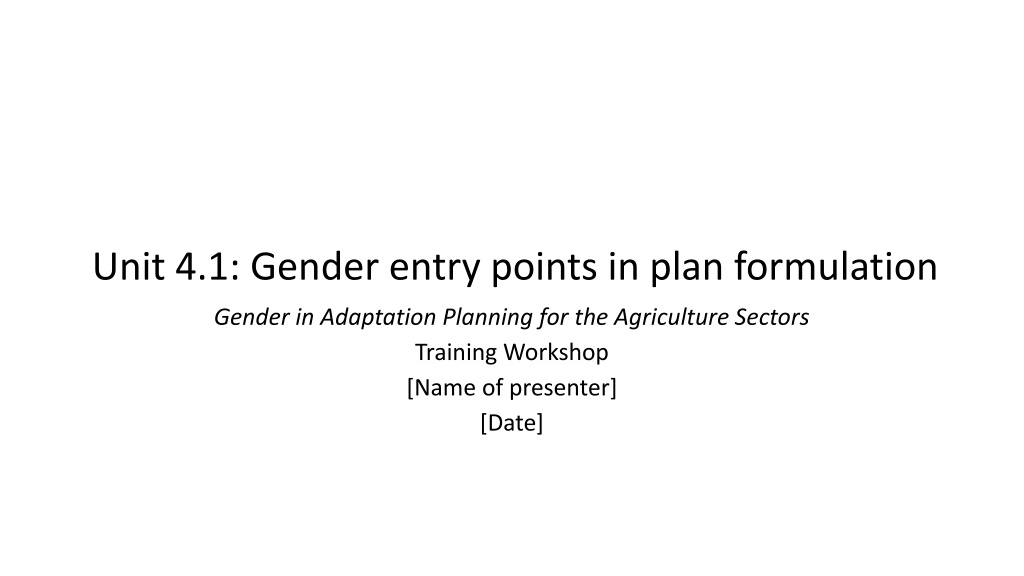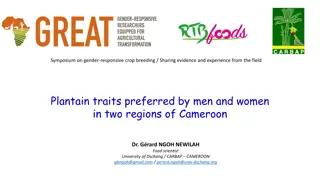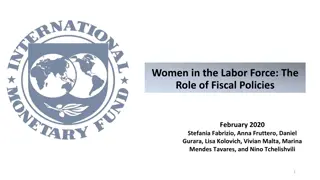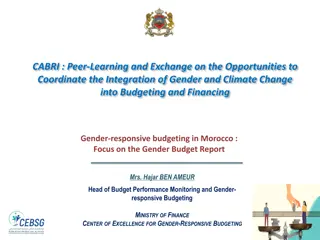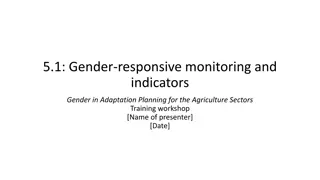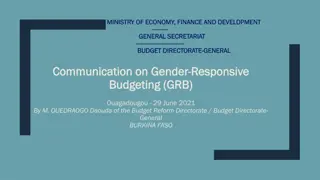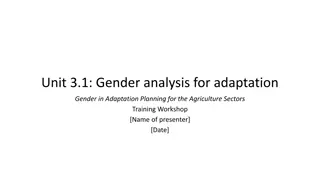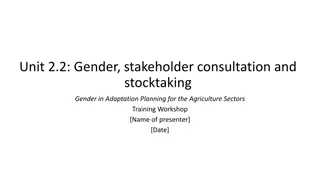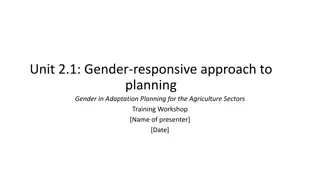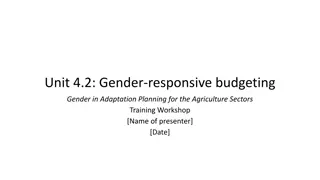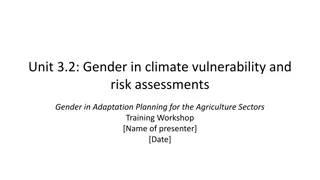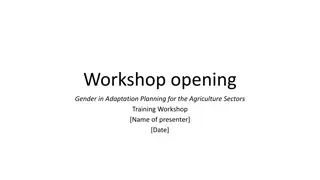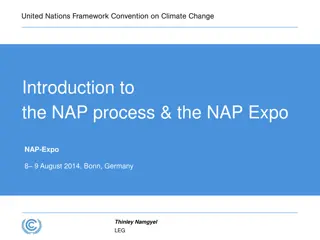Gender-Responsive Adaptation Planning in Agriculture Sectors
This workshop explores gender entry points in plan formulation for agriculture adaptation, emphasizing the importance of considering gender differences. It discusses key characteristics of gender-responsive plans, actions to ensure gender inclusion, and potential risks of neglecting gender perspectives in agricultural planning. The training focuses on promoting gender equality through equitable participation, influence, and access to resources for both women and men in adaptation decision-making processes.
Download Presentation

Please find below an Image/Link to download the presentation.
The content on the website is provided AS IS for your information and personal use only. It may not be sold, licensed, or shared on other websites without obtaining consent from the author. Download presentation by click this link. If you encounter any issues during the download, it is possible that the publisher has removed the file from their server.
E N D
Presentation Transcript
Unit 4.1: Gender entry points in plan formulation Gender in Adaptation Planning for the Agriculture Sectors Training Workshop [Name of presenter] [Date]
Learning outcomes Describe the key characteristics of a gender-responsive adaptation plan for agriculture. Describe Identify actions to take to ensure that gender is reflected in each section of a plan document. Identify Give Give examples of adaptation options that reflect a gender-responsive approach.
Gender-responsive adaptation plan for agriculture Contributes to gender equality through: Recognition of gender differences in adaptation needs, opportunities and capacities Equitable participation and influence by women and men in adaptation decision-making processes Equitable access to financial resources and other benefits resulting from investments in adaptation between women and men Source: NAP Global Network. 2017. A Framework for Gender- Responsive National Adaptation Plan (NAP) Processes
If gender is not considered? The plan could risk reinforcing existing gender gaps in agriculture and discriminatory practices, and thus fail to meet its objectives. Other risks?
Gender-responsive stakeholder engagement Engaging with stakeholders addressing gender can lead to more equitable adaptation options. Diverse stakeholders = diverse perspectives. Potential stakeholders with gender perspective*: Ministry of Gender, similar government bodies NGOs/CSOs working on gender issues farmers organizations women s organization research institutions/universities. Dedicated resources to support engagement process * Note: May not have much climate change-related experience
Gender Action Plan succinct list of goals, responsibilities and deadlines that are agreed to by members of the planning process can serve as a checklist for the adaptation planning group to ensure that gender is being integrated throughout the formulation of the plan a guide for further action instead of an endpoint follow-through possible when there is leadership, staff time, and allocation of financial resources
Key actions to address gender in an adaptation plan for agriculture Throughout: Use specific language (e.g. women and men instead of farmers ) Avoid equating gender with women and framing women as vulnerable Reflect findings on gender-based differences in risk and vulnerability Elaborate on roles of different organizations related to gender equality Use sex-disaggregated data Ask: Where is the gender perspective? Do the proposed strategies and actions promote gender equality or worsen existing gender gaps?
Gender in each section of the plan (1/4) 1. Preamble and Justification Relevant national and international commitments on gender equality Importance of gender in context of adaptation in agriculture 2. Methodology for developing the plan How gender expertise applied throughout by various organizations, experts 3. Context Gender in national development context (e.g. education, employment in ag) Gender issues in agriculture (results of gender analysis) Climate trends as observed by rural women and men
Gender in each section of the plan (2/4) 4. Climate change impacts and vulnerability analysis Gender dimensions of vulnerability to climate change impacts including women s and men s priorities, opportunities, and constraints in responding to the impacts. 5. Policy and institutional framework Roles of key stakeholders in meeting gender equality commitments, including those in existing agriculture and climate change policies/plans Possible barriers to gender-responsive policy implementation (e.g. lack of collaboration between key ministries)
Gender in each section of the plan (3/4) 6. Priority adaptation options Vision, objectives and guiding principles may include gender-responsiveness Adaptation options Describe gender considerations used when identifying adaptation options, e.g. access to information/climate services, participation in decision-making, participation in groups, constraining cultural norms, and more. One gender-focused adaptation option, e.g. Promote a gender-responsive climate smart agriculture programme . Reflect consideration of gender in all adaptation options, e.g. Gender consideration How reflected in an adaptation option Work burden Develop specific technologies tailored to women s needs; prioritize adaptation practices that reduce the work loads of women and men Vulnerability encourage transition from coping strategies to adaptation by targeting women s and men s needs.
Gender in each section of the plan (4/4) 7. Coordination and implementation arrangements Describe institutional arrangements, roles and responsibilities to mainstream gender in implementation Identify how to close skills gaps 8. Monitoring, reporting and evaluation Develop a gender-responsive monitoring framework 9. Financing and resource mobilization Use gender-responsive budgeting principles to allocate resources Refer to efforts to meet gender requirements of donors
